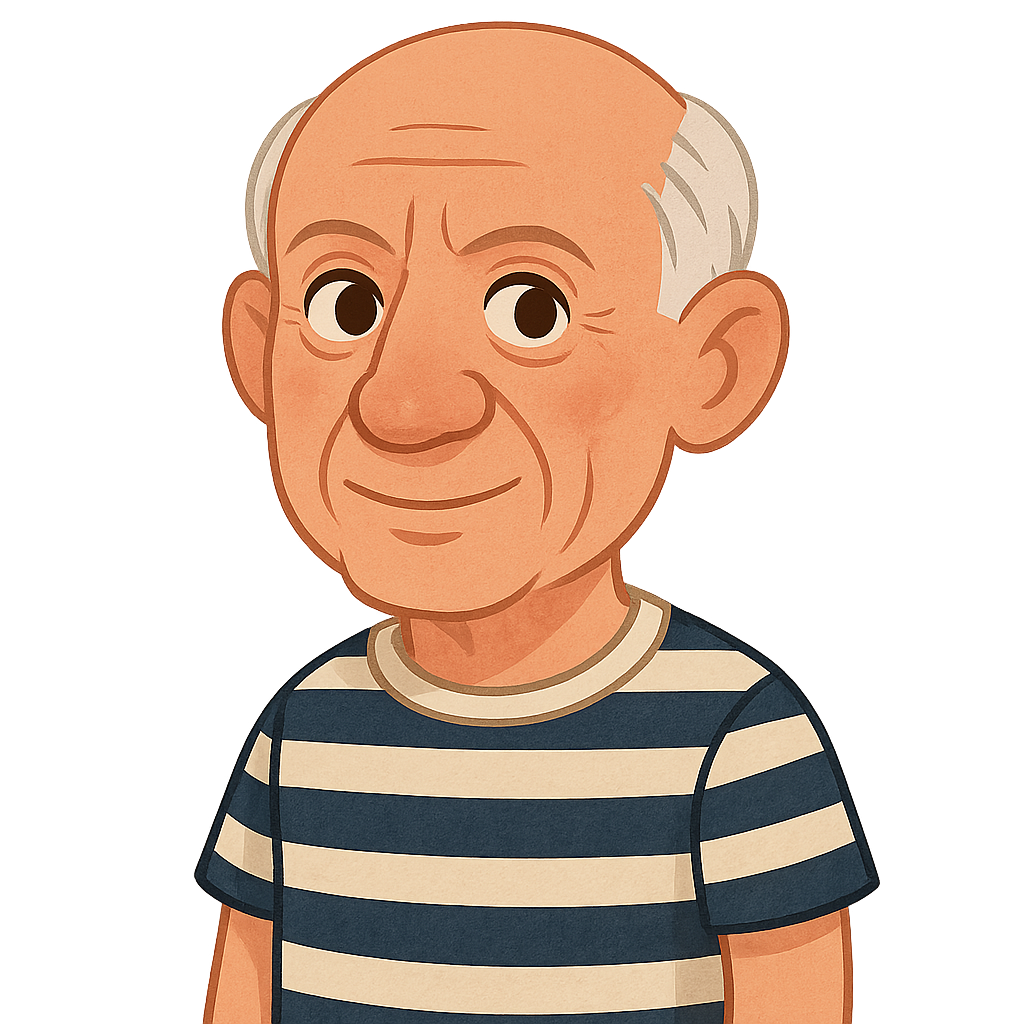Pablo Picasso: A Story Told in Shapes and Colors
Hello, my name is Pablo Picasso, and I am a painter. You might have seen my paintings, which are full of strange shapes and bright colors. They look a bit different from other pictures, and that's because I believed that art should come from your imagination. My story begins not in a fancy art museum, but in a sunny city in Spain. I was born in Málaga, Spain, way back in 1881. From the very beginning, art was in my blood. My father, José, was an artist and an art professor, and our home was always filled with the smell of oil paints and the sight of canvases leaning against the walls. I loved it. In fact, people say my very first word wasn't 'mama' or 'papa,' but 'piz.' It was my baby-talk way of saying 'lápiz,' which is the Spanish word for pencil. I was always drawing, sketching on any scrap of paper I could find. My father was my first teacher, and he saw that I had a special spark. When I was just thirteen years old, he gave me a great gift. After watching me finish a painting with skill that amazed him, he handed me his own personal brushes and palette of paints. It was his way of saying, 'Your journey as an artist begins now.'
When I grew older, I knew I had to go where all the exciting new art was being made: Paris, France. The city was a whirlwind of energy, filled with artists and thinkers who wanted to change the world with their ideas. At first, it was a lonely and difficult time for me. A dear friend had died, and I felt a deep sadness in my heart. I poured all of that feeling onto my canvases, using every shade of blue you can imagine. This is now called my 'Blue Period.' My paintings from this time were quiet and sorrowful, showing the struggles of poor and forgotten people. But feelings, like colors, can change. After a while, I found happiness and love in Paris, and my world brightened. A warm glow entered my life, and my paintings followed. I began using lovely pinks, warm oranges, and earthy reds. This became my 'Rose Period,' and I painted circus performers, clowns, and dancers—people who brought joy to the world. It was during this time that I met another artist named Georges Braque. Together, we had a revolutionary idea. We thought, 'Why must a painting show something from only one angle?' We started a new style called Cubism. We would take an object, like a guitar or a face, and paint it as if we were seeing it from the front, the back, and the sides all at the same time. We broke things down into geometric shapes—cubes, cones, and squares—and put them back together in a new, exciting way. It was like solving a puzzle on the canvas, and it changed art forever.
Art isn't just for making pretty pictures. It can also be a powerful voice. In 1937, something terrible happened in my home country. A civil war had broken out in Spain, and I heard the news that a small, peaceful town called Guernica had been bombed. My heart ached for the innocent people who were hurt. I was living in Paris and felt so far away, but I knew I had to do something. I couldn't fight with a weapon, but I could fight with my paintbrush. I decided to paint a huge mural, a painting so big that no one could ignore it. I wanted it to be a scream against war and a reminder of its cruelty. I didn't use any happy colors for this painting, which I named 'Guernica.' I only used black, white, and shades of grey, the colors of newsprint and sorrow. In the painting, you can see the chaos and fear—a mother crying out while holding her child, a wounded horse screaming, and buildings on fire. It was my way of showing the world the ugliness of violence and my deep hope for peace.
I lived a very long life, until the year 1973, and I never stopped creating. Art was like breathing to me. Even when I was an old man with white hair, my mind was buzzing with new ideas. I didn't just paint. I made sculptures out of things I found, like an old bicycle seat and handlebars that I turned into the head of a bull. I designed colorful ceramic plates and vases, and I made thousands of prints. For me, creating was about playing and discovering. Looking back, I see that art is not about copying the world exactly as it is. It's about showing how you feel, what you think, and how you see things in your own special way. Everyone has an artist inside them. So, I hope my story inspires you to pick up a pencil or a paintbrush and show the world the wonderful pictures that are waiting in your imagination.
Reading Comprehension Questions
Click to see answer
